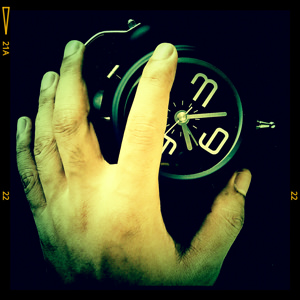The Case Against Hitting Snooze
We've all been guilty of trying to catch a few more minutes of shut-eye in the mornings as our alarm reminds us it's time to face the day. However, though it may feel like you're cheating the clock when you hit the snooze button, you're actually doing your body more harm than good.
We’ve all been guilty of trying to catch a few more minutes of shut-eye in the mornings as our alarm reminds us it’s time to face the day. However, though it may feel like you’re cheating the clock when you hit the snooze button, you’re actually doing your body more harm than good.
Apparently, wandering back into dream world during the extra time that snooze affords you can return you to the first step of the sleep cycle, making it more difficult to wake up. What’s worse is waking with such difficulty will also make you feel less rested, a feeling that’s hard to shake for the remainder of the day. According to The New Yorker:
One of the consequences of waking up suddenly, and too early, is a phenomenon called sleep inertia. First given a name in 1976, sleep inertia refers to that period between waking and being fully awake when you feel groggy. The more abruptly you are awakened, the more severe the sleep inertia. While we may feel that we wake up quickly enough, transitioning easily between sleep mode and awake mode, the process is in reality far more gradual. Our brain-stem arousal systems (the parts of the brain responsible for basic physiological functioning) are activated almost instantly. But our cortical regions, especially the prefrontal cortex (the part of the brain involved in decision-making and self-control), take longer to come on board.
In those early waking minutes, our memory, reaction time, ability to perform basic mathematical tasks, and alertness and attention all suffer. Even simple tasks, like finding and turning on the light switch, become far more complicated. As a result, our decisions are neither rational nor optimal. In fact, according to Kenneth Wright, a neuroscientist and chronobiology expert, “Cognition is best several hours prior to habitual sleep time, and worst near habitual wake time.” In the grip of sleep inertia, we may well do something we know we shouldn’t. Whether or not to hit the snooze button is just about the first decision we make. Little wonder that it’s not always the optimal one.
Other research has found that sleep inertia can last two hours or longer. In one study that monitored people for three days in a row, the sleep researchers Charles Czeisler and Megan Jewett and their colleagues at Harvard Medical School found that sleep inertia took anywhere from two to four hours to disappear completely. While the participants said they felt awake after two-thirds of an hour, their cognitive faculties didn’t entirely catch up for several hours. Eating breakfast, showering, or turning on all the lights for maximum morning brightness didn’t mitigate the results. No matter what, our brains take far longer than we might expect to get up to speed.
When we do wake up naturally, as on a relaxed weekend morning, we do so based mainly on two factors: the amount of external light and the setting of our internal alarm clock—our circadian rhythm. The internal clock isn’t perfectly correlated with the external one, and so every day, we use outside time cues, called zeitgebers, to make fine adjustments that mimic the changes in light and dark that take place throughout the year.
The difference between one’s actual, socially mandated wake-up time and one’s natural, biologically optimal wake-up time is something that Till Roenneberg, a professor of chronobiology at Ludwig-Maximilians University in Munich, calls “social jetlag.” It’s a measurement not of sleep duration but of sleep timing: Are we sleeping in the windows of time that are best for our bodies?
Social jet lag can cause an increase in caffeine and alcohol intake due to a lack of optimal sleep. And, as we found out last year, alarm clocks disrupt our internal body clocks, raising our chances of obesity by 33 percent.
But what’s a busy person to do in this fast-paced world? Most of us don’t have the luxury of sleeping enough or waking whenever our body feels it should. According to neuroscientist Wright, if we adjusted our sleeping schedules so that they were more closely tied to natural light patterns, our cognitive abilities throughout the day could improve drastically. And apparently, this used to be possible in the early 1800s when the U.S. had 144 time zones, with each city setting its own time so that 12 o’clock would be synced with when the sun was at its highest point in the sky.
Imagining the possibilities of a more alert population is enough to make you want to turn back time. And although time travel may not be possible, a good start to feeling less sluggish in the mornings may be avoiding the snooze button altogether, as painful as it may seem at the time.
—Posted by Natasha Hakimi
Your support matters…Independent journalism is under threat and overshadowed by heavily funded mainstream media.
You can help level the playing field. Become a member.
Your tax-deductible contribution keeps us digging beneath the headlines to give you thought-provoking, investigative reporting and analysis that unearths what's really happening- without compromise.
Give today to support our courageous, independent journalists.






You need to be a supporter to comment.
There are currently no responses to this article.
Be the first to respond.